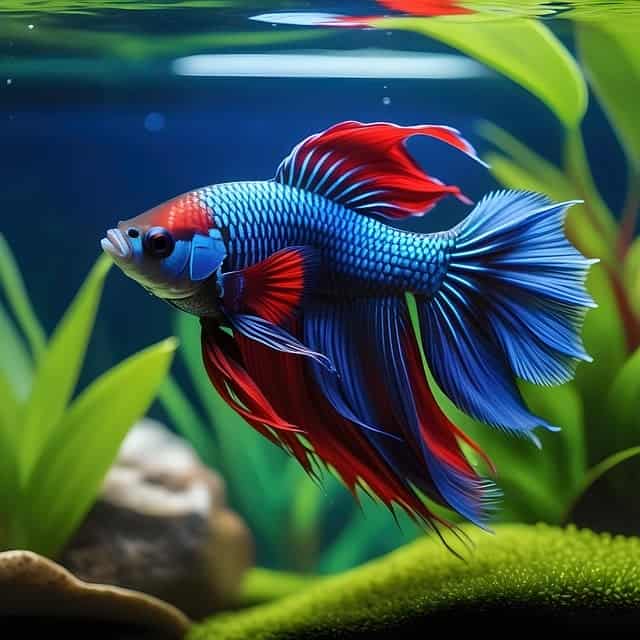Betta fish, also known as Siamese fighting fish, are popular freshwater aquarium fish native to Southeast Asia.
With their vibrant colors and flowing fins, bettas are a beautiful addition to any fish tank. But what exactly can these fish see and how do they behave in low light or darkness?
Betta fish have unique eyes adapted for seeing well in dark, murky waters. Their eye structure allows them to detect prey, mates, and threats even in extremely dim lighting.
Unlike humans who rely primarily on cone cells for color vision, bettas have both rod and cone cells in their retinas optimized for low-light vision as well as detecting color.
In this article, we’ll take a deep dive into betta fish vision capabilities. We’ll explore their eye anatomy that facilitates low light vision, behaviors in dark versus light tank conditions, and considerations for lighting in a betta aquarium.
Get ready to learn how bettas make use of specialized eyes to thrive in the dark waters of Southeast Asia.
Betta Fish Eye Structure
Betta fish have eyes that share the basic vertebrate eye anatomy. Their eyes contain a lens, iris, pupil, cornea, and retina. The retina is a thin layer of tissue at the back interior of the eye that contains photoreceptor cells.
There are two main types of photoreceptor cells in the retina – rods and cones. Rod cells detect light and motion and allow vision in low-light conditions. Cone cells detect color and require brighter light to function.
The betta fish retina contains both rod and cone cells. The rods are distributed across the retina, enabling bettas to see in darker environments. The cones are concentrated in a central area called the fovea, giving them good daytime color vision.
Having both rod and cone cells allows bettas to see well in varying light conditions. The rod cells allow them to navigate, find food, and avoid danger even in darkness.
Rod Cells for Low Light Vision
Betta fish have special cells in their eyes called rod cells that allow them to see in low-light conditions. Rod cells contain a light-sensitive pigment called rhodopsin that absorbs photons well even with very little light present.
When light hits the rhodopsin in a rod cell, it triggers a cascade of chemical reactions that ultimately send a signal to the brain indicating that light was detected.
Rod cells are extremely sensitive and can detect a single photon of light. This allows bettas to see when ambient light levels are very low, such as at night or in dark or murky water.
The rod cells in a betta’s eye are optimized for night vision. They are very sensitive to light but lack color detection ability. The abundance of rod cells gives bettas excellent low-light capabilities.
But they sacrifice visual sharpness and color in exchange for the ability to see forms, shapes, and movements under dark conditions.
Cone Cells for Color Vision
Betta fish have cone-shaped photoreceptor cells called “cone cells” in their retinas that allow them to see color and fine detail.
Cone cells contain light-sensitive pigments that are triggered by different wavelengths of light. There are multiple types of cones, each responsive to a different range of colors. The cone cells of betta fish contain pigments sensitive to red, green, and blue light.
This gives them trichromatic color vision very similar to that of humans. The cone cells are concentrated in the area of the retina called the fovea.
This gives bettas excellent daytime vision and the ability to detect rapid movements and recognize color, which helps them find food and interact with mating displays.
The cone cells allow bettas to see the vivid colors of their companions, as well as appreciate the colorful tails and fins of potential mates.
So while you may think your betta’s tank decorations look nice to you, your betta can appreciate the colors even more with specialized cone cells granting them color vision.
Betta Fish Have Both Rods and Cones
Like many fish, bettas have specialized cells in their eyes called rods and cones that allow them to see in low-light conditions. Rods detect light and motion, but not color.
They contain a light-sensitive pigment called rhodopsin that reacts quickly to low levels of light. Cones detect color and fine details when light is brighter.
Bettas are equipped with both rod and cone cells, giving them the ability to see in a wide range of light conditions. The rods allow them to detect shapes, movement, and gradients of light and dark even when it’s nearly pitch black.
The cones let them see colors, patterns, and details when the tank lights are on. Having both types of photoreceptor cells is an adaptation that helps bettas survive in the shallow rice paddies and sluggish brown waters that are their natural habitat.
The water is murky and light levels can change drastically throughout the day.
So while betta vision in total darkness is limited, their eyes are well adapted to make the most of available light. This gives them an advantage in low light conditions over species like goldfish that only have cones.
It also means bettas can transition smoothly between a dim tank at night and brighter daytime lighting. Their versatile eyesight works well in the captive environment of a home aquarium.
Behavior in Dark vs. Light Conditions
Betta fish exhibit some noticeable changes in behavior when their environment shifts from day to night. Here’s an overview of how betta behavior adapts to low-light conditions:
– Activity Levels – Bettas tend to be less active when the lights are out. You’ll notice less swimming around and more resting. Their metabolism slows down at night.
– Sleeping: Bettas do sleep at night! They find a resting spot, become still, and their gill movements slow. Their sleep cycles are shorter than humans at just a few minutes.
– Colors Fade: A betta’s bright colors won’t appear as vivid under low light. The reds, blues, and greens seem to fade or wash out without proper illumination.
– Fin Clamping: Some bettas clamp their large fins in at night, likely to make themselves less visible to predators. The fins press against the body instead of flaring out.
– Boldness: Low light makes bettas feel more secure, so they may venture out from hiding spots more often. Shy bettas become more brave at night.
– Reaction Time: Bettas won’t flinch or dart away as quickly when startled at night. Their reaction time is delayed without bright light.
So in summary, bettas exhibit more lethargic, cautious behavior geared towards rest and survival during their low-light active hours. Their vibrant daytime colors and activities return under proper aquarium lighting.
Tank Lighting Considerations
When setting up the lighting for your betta tank, it’s important to consider their ability to see in low light conditions. Bettas don’t need extremely bright lighting, but some light is necessary for their health and well-being. Here are some best practices for betta tank lighting:
– Use a low-wattage bulb or LED aquarium light. 5-10 watts per gallon is sufficient. Avoid bulbs that are too bright or produce a lot of heat.
– If possible, install a timer to provide a consistent daily cycle of 8-12 hours of light. This mimics their natural habitat. Complete darkness stresses Bettas.
– Position the light to brightly illuminate only certain areas of the tank. This creates a gradient of light and shadow that bettas appreciate.
– Try a moonlight or nighttime blue bulb to provide some low-level lighting at night. Bettas are active in dawn and dusk conditions.
– Heavily planted tanks help create shaded areas for bettas to retreat to if the lighting is too bright. Floating plants are especially helpful.
– For tanks with multiple fish, give bettas plenty of hiding spots and caves. This allows them to get away from light if stressed.
With some simple adjustments to your aquarium lighting, you can create the perfect day and night lighting environment tailored to your betta’s senses. This will support their health and natural behaviors.
Other Low Light Adaptations
Bettas have additional adaptations that allow them to see well in low-light conditions beyond their rod and cone cells. One is a reflective layer that lines the back of their eyes called the tapetum lucidum.
This layer acts like a mirror, reflecting light through the retina to give light-sensitive cells a second chance to detect the image. This is why betta eyes often seem to glow or shine in dim conditions or when a light shines on them.
Bettas can also dilate their pupils to allow more light into the eye. Like a camera aperture opening wider, pupil dilation exposes more of the light-sensitive cells in the retina to the available light.
This helps bettas maximize their vision even in very dark conditions by capturing as much of the scarce ambient light as possible.
So while bettas don’t have “night vision” per se, their eye structure and adaptations allow them to see fairly well even in very low light. This allows them to remain active after tank lights go off and still navigate their environment effectively.
Mythbusting Betta Night Vision
While betta fish can see better in low light than humans, some misconceptions exist about their night vision abilities. Bettas do not have supernatural night vision. Their vision in the dark is limited by the following factors:
– Bettas still need some light to see. Their vision deteriorates in complete darkness or pitch-black conditions. They cannot see in the infrared or complete absence of light.
– Their vision is blurry and less colorful in low light. While their rod cells allow them to detect shapes and movement, details and colors are not as sharp.
– Their eyes do not physically glow or illuminate in the dark. Any retina will reflect light, which causes a visible shine or colored sheen, but betta eyes do not produce their own light.
– Bettas are not nocturnal fish, so their prime feeding and activity times are still during daylight hours. Their vision is adapted for dawn/dusk, but not complete nighttime conditions.
– While bettas can navigate a familiar space in low light, their reaction times slow in the dark. They still prefer and thrive most actively under daytime aquarium lighting.
So in summary, bettas do have good low-light vision compared to humans, but true “night vision” is limited.
Their eyes are not transformed at night. With proper tank lighting and shelter, bettas can transition smoothly from day to night vision as needed.
Summary
Betta fish have some remarkable adaptations that allow them to see quite well in low-light conditions.
Their eyes contain both rod cells and cone cells, giving them the ability to detect shapes and movements in the dark along with discern colors when light is available.
While bettas can’t see perfectly in pitch blackness, their rod cells allow them to navigate through shadows and dim environments.
This explains why bettas continue to swim around and interact with their surroundings when tank lights are off at night.
It also shows why lighting should be kept low for bettas, as extremely bright lights can stress them.
Overall, bettas do have exceptional night vision compared to other fish. With their unique eye structure and evolutionary adaptations, bettas are equipped to see and function even when it’s dark.
While they may not have superpowers, their vision in low-light conditions is impressive. With a basic understanding of their eyes and behavior, you can provide the best possible habitat and care for your betta.

